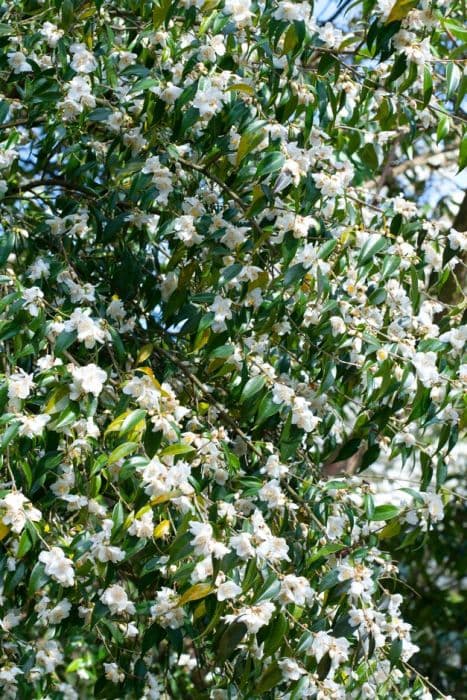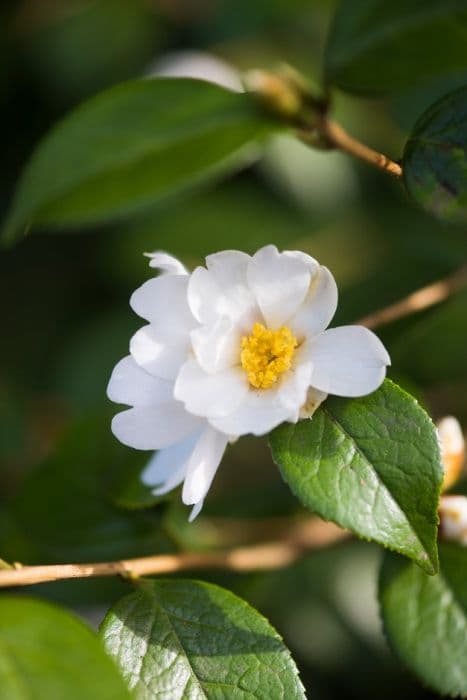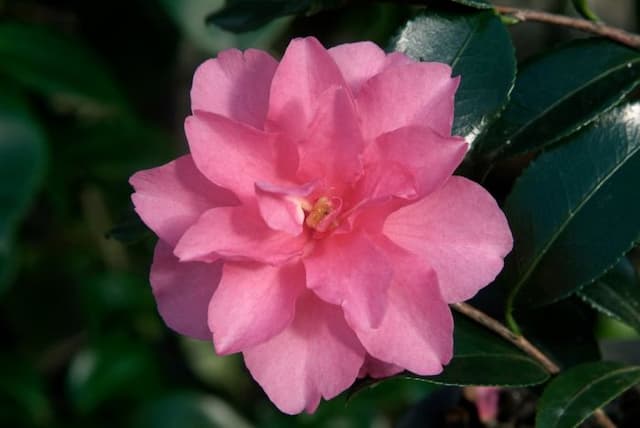Japanese Camellia Camellia 'Crimson Candles'

ABOUT
Camellia 'Crimson Candles' is a striking plant known for its beautiful and distinctive blooms. The flowers are a deep crimson color, often presenting a rich, velvety texture, and they tend to retain their vibrancy throughout their bloom period. Each flower consists of numerous petals arranged in a layered, somewhat ruffled fashion, lending it a full and lush appearance. The plant itself is a broadleaf evergreen, meaning it keeps its glossy green leaves year-round, which provide an attractive backdrop to the vibrant blooms. The leaves have a classic oval shape and come to a soft point, with edges that are gently serrated. These leaves are usually deep green and have a leathery texture with a shiny surface that catches the light, underscoring the brilliance of the crimson flowers. As the name suggests, 'Crimson Candles' can offer the appearance of glowing red candles amidst its foliage, due to the way the buds and flowers perch on the branches. The buds themselves are also notable for their distinctive shape and color, with a tendency to stand upright on the stems before opening into full blooms. Overall, Camellia 'Crimson Candles' is a stunning plant celebrated for its year-long foliar interest and its seasonal floral display, characterized by the striking contrast between the deep red of its flowers and the lush greenery of its leaves.
About this plant
 Names
NamesFamily
Theaceae.
Synonyms
Crimson Candles Camellia.
Common names
Camellia 'Crimson Candles'.
 Toxicity
ToxicityTo humans
Camellia 'Crimson Candles', commonly known as Camellia, is generally not considered toxic to humans. Most camellias are regarded as safe, and there are no well-documented cases of poisoning from ingesting parts of this plant. However, it's always advisable to err on the side of caution and avoid consuming plant parts that are not commonly used as food, as individual sensitivities can vary.
To pets
Camellia 'Crimson Candles', commonly known as Camellia, is not typically toxic to pets. Camellias are generally considered to be low-risk plants for animals, and there are no widespread reports of adverse effects from pets ingesting parts of these plants. Nonetheless, consuming plant material can sometimes result in mild gastrointestinal upset for pets, so it's prudent to monitor animals and keep ornamental plants out of their reach whenever possible.
 Characteristics
CharacteristicsLife cycle
Perennials
Foliage type
Evergreen
Color of leaves
Dark green
Flower color
Pink
Height
6-8 feet (1.8-2.4 meters)
Spread
6-8 feet (1.8-2.4 meters)
Plant type
Shrub
Hardiness zones
7
Native area
Japan
Benefits
 General Benefits
General Benefits- Attractive Blooms: Produces deep pink, candle-like buds that open into lovely, rose-like flowers, adding beauty to the garden.
- Long Flowering Period: Boasts a long flowering season, typically from winter to early spring, providing color when few other plants are in bloom.
- Evergreen Foliage: Maintains its glossy, dark green leaves throughout the year, offering constant visual interest in the landscape.
- Compact Growth: Its upright and somewhat compact growth habit makes it suitable for smaller gardens or for use in borders and beds.
- Drought Tolerance: Once established, it exhibits a degree of drought resistance, reducing the need for frequent watering.
- Pest Resistance: Generally resilient to many common pests, making it a low-maintenance choice for the garden.
- Cold Hardiness: Displays a level of cold hardiness, able to withstand cooler climates and frost conditions.
- Versatile Landscaping Use: Can be used in a variety of landscaping designs, including as a specimen plant, in mixed shrub borders, or container gardens.
- Attracts Pollinators: The flowers attract bees and other pollinators, supporting local ecosystems and promoting biodiversity.
- Cultural Significance: Associated with the Camellia genus, which has historical and cultural importance in many parts of the world, particularly in East Asia.
 Medical Properties
Medical PropertiesThis plant is not used for medical purposes.
 Air-purifying Qualities
Air-purifying QualitiesThis plant is not specifically known for air purifying qualities.
 Other Uses
Other Uses- Floral Arrangements: The vibrant, crimson blooms of the Camellia can be used to create stunning floral arrangements, especially when paired with white or pale flowers for contrast.
- Crafting Dyes: The petals of the Camellia 'Crimson Candles' may be used to produce natural dyes for textiles, offering a range of pink to red hues.
- Cooking Oil: The seeds of Camellia plants are sometimes pressed to extract oil that can be used in cooking, similar to olive or vegetable oil.
- Photography Subject: Due to its striking appearance, the Camellia 'Crimson Candles' is often photographed by botanical and nature photographers as a subject for their work.
- Insectary Plant: Camellias can be planted to attract beneficial insects to the garden, which can aid in pollination and pest control.
- Tea Ceremony Decor: In cultures where tea ceremonies are prevalent, Camellia flowers might be used as decor to enhance the aesthetic and ambiance of the ceremony.
- Education and Research: Camellia 'Crimson Candles' can be used in educational settings to teach botany and horticulture students about plant care and breeding techniques.
- Luck and Prosperity Symbol: In some cultures, the Camellia flower is a symbol of luck and prosperity and can be given as a gift to convey these wishes.
- Specialty Mulches: Fallen Camellia petals and leaves can be composed into mulch for garden beds, providing both nutrients to the soil and an attractive ground cover.
- Artistic Inspiration: The beauty of the Camellia 'Crimson Candles' often serves as inspiration for artists and can be found depicted in watercolor, oil paintings, and other forms of art.
Interesting Facts
 Feng Shui
Feng ShuiThe Camellia is not used in Feng Shui practice.
 Zodiac Sign Compitability
Zodiac Sign CompitabilityThe Camellia is not used in astrology practice.
 Plant Symbolism
Plant Symbolism- Adoration: The camellia flower is often associated with adoration and deep longing. Due to its vivid color and beautiful blooms, it is often given as a sign of someone's intense admiration and interest.
- Devotion: This plant is symbolic of devotion and loyalty, given their tendency to bloom reliably every year, which can reflect steadfastness in a relationship.
- Perfection: Camellias have often been admired for their perfect, intricate blossoms and are associated with the ideal or flawless beauty.
- Refinement: The elegant and delicate appearance of camellias is associated with refinement and purity, making them a suitable gift for someone who appreciates the finer things in life.
- Love: Given their rich color and attractive form, camellias frequently symbolize love and affection, especially the deeper and passionate varieties of these emotions.
 Water
WaterCamellia 'Crimson Candles', commonly known as 'Crimson Candles' Camellia, generally requires watering every 7 to 10 days during active growth, decreasing to every 2 to 3 weeks in the dormant winter period. The soil around the camellia should be kept moist but not saturated; use a gentle stream of water to avoid disturbing the soil. For established plants, a deep watering with about 1 to 1.5 gallons per session is typically sufficient. Make sure to water at the base of the plant, avoiding wetting the foliage to prevent fungal diseases. During hot, dry periods, additional watering may be necessary.
 Light
Light'Crimson Candles' Camellia thrives in partial shade to filtered sunlight. The best spot for this plant is one that receives morning sunlight but is protected from the intense heat of the afternoon sun. Dappled shade throughout the day is ideal for this camellia, as too much direct sunlight can lead to leaf burn, while too little can diminish flowering.
 Temperature
Temperature'Crimson Candles' Camellia prefers temperatures ranging between 60°F and 80°F for optimal growth. It can withstand minimum temperatures down to around 20°F, but temperatures below freezing can damage the plant, particularly its flower buds. The ideal temperature range for camellias to flourish is between 70°F and 75°F during their active growing season.
 Pruning
Pruning'Crimson Candles' Camellia should be pruned to maintain shape and promote healthy growth. Pruning is best done after flowering has finished, typically in late winter or early spring. Remove dead or weak wood, and trim back shoots to shape the plant or control its size. Light pruning can be done annually, while more extensive pruning should be done every few years to rejuvenate older plants.
 Cleaning
CleaningAs needed
 Soil
SoilCamellia 'Crimson Candles' thrives in acidic, well-draining soil with a pH of 5.5 to 6.5. A mix of 2 parts peat moss, 1 part perlite, and 1 part pine bark is ideal for providing the necessary drainage and acidity.
 Repotting
RepottingCamellias generally require repotting every 2 to 3 years. It's best to repot 'Crimson Candles' in spring before the growing season begins.
 Humidity & Misting
Humidity & MistingCamellias thrive at a humidity level of 40% to 60%. 'Crimson Candles' Camellia enjoys high humidity, but good air circulation is also necessary to prevent fungal diseases.
 Suitable locations
Suitable locationsIndoor
Place 'Crimson Candles' near a window with filtered sunlight, away from drafts.
Outdoor
Plant 'Crimson Candles' in partial shade with shelter from strong wind.
Hardiness zone
7-9 USDA
 Life cycle
Life cycleThe life cycle of the Camellia 'Crimson Candles', commonly known as Camellia, begins with seed germination, where under the right conditions of moisture and temperature, the seed develops into a seedling. Once the seedling emerges, it enters the vegetative growth stage, producing leaves and stems as it becomes a young plant. As the camellia matures, it enters the flowering stage, producing vibrant red flowers that are characteristic of the 'Crimson Candles' variety, typically during late winter to early spring. After pollination, the flowers develop into seed pods, and once mature, these pods release seeds, continuing the reproductive cycle. The camellia plant then goes through a period of growth and dormancy, reacting to seasonal changes, and over years, it can grow into a substantial shrub. Throughout its life, the Camellia 'Crimson Candles' will undergo repeated cycles of growth, flowering, and seeding, provided it is cared for with appropriate horticultural practices.
 Propogation
PropogationPropogation time
Spring-Summer
Propogation: Camellia 'Crimson Candles', commonly known as the Camellia, is best propagated by semi-hardwood cuttings taken in late summer or early fall. A semi-hardwood cutting is a portion of stem taken from the current year's growth that has begun to mature; it's neither too soft nor fully hardened. To propagate, you should cut a 4 to 6-inch length (approximately 10 to 15 cm) just below a leaf node and remove the leaves from the lower half of the cutting. Dip the cut end into rooting hormone to enhance root development. The cutting should then be placed in a pot filled with a mix of perlite and peat, ensuring that at least two nodes are buried in the medium. The pot needs to be kept in a humid environment with indirect light and a consistent temperature, where roots will develop in several weeks to a few months.









